Hood to the bathroom: selection rules and installation features
The bathroom is characterized by high humidity. Steam condenses on the ceiling and walls, resulting in mold and mildew. To prevent these processes, it is necessary to responsibly approach the issues of arranging ventilation and selecting an exhaust fan. Do you agree?
We will tell you about which hood in the bathroom will be your best solution. In the article we proposed, varieties are described in detail, landmarks for choosing the best option are given. Independent home masters with us will find a step-by-step guide and practical advice on how to carry out installation.
The content of the article:
- Types of exhaust fans
- Types of ventilation in the bathroom
- Types of fans for enclosed spaces
- The main parameters of the hood for the bath
- How to choose the right device?
- Preparing a place for an exhaust fan
- Choosing the optimal connection scheme
- Installation procedure
- Conclusions and useful video on the topic
Types of exhaust fans
Modern hoods designed for installation in the bathroom are conventionally divided into 2 types: simple and automatic. They differ from each other in design, availability of additional options and cost. Hood should feed from 25 m3/ h of fresh air for a separate room, from 50 m3 in the case of a combined bathroom.
Simple equipment is an electric fan, which is located in a tubular plastic housing. It can be of two types - built-in or freestanding.
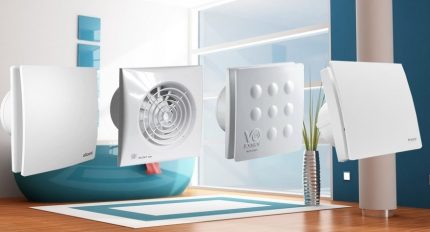
A popular way to turn on the device is by pressing a switch that provides lighting in the bathroom. This option allows the removal of contaminated air from the bathroom when a person is in it.
The automatic equipment is equipped with electronics that effectively control the operation of the device.
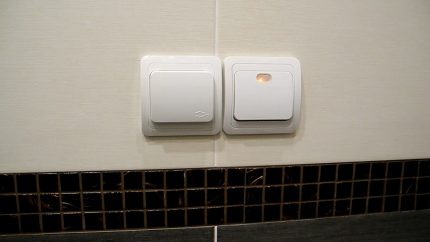
Hoods are equipped with additional functions:
- off timer;
- humidity sensors;
- color backlight.
The fan turns on when the permissible humidity value is exceeded. As soon as this parameter returns to normal, the device turns off.
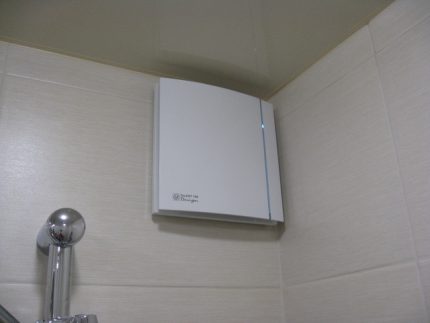
Automatic products can be equipped with other functions. In private houses, the ventilation system directly communicates with the street, so their owners will not be damaged by a fan on the supply pipe with an adjustable diffuser.
Part models equipped with a check valvenot allowing air to move in the opposite direction. This option is useful for residents of apartments in high-rise buildings to protect themselves from the aromas of the neighboring bathroom.
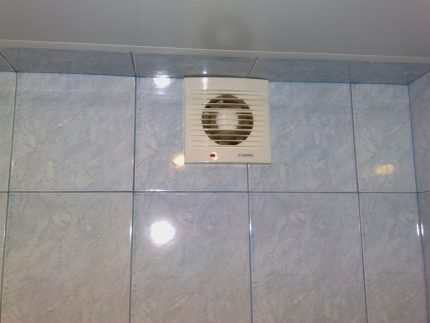
A modern range hood designed for installation in the bathroom has a compulsory operating principle. The device consists of a fan and an air duct connected to the ventilation duct of the building.
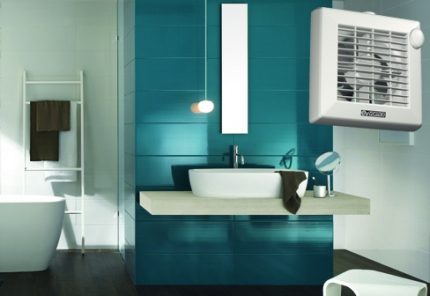
To choose the optimal hood, you will have to take into account the features of the bathroom and the varieties of existing ventilation systems. Devices can differ in design, operating principle, power and the presence of additional functions.
Types of ventilation in the bathroom
To ensure air exchange indoors, natural or forced ventilation can be used. The first option does not require the use of special equipment that performs certain functions.
The second involves the use of fans, air heaters, engines, devices for cooling air and other additional devices. Introduces the principles of ventilation in sanitary-hygienic premises next article, which we strongly recommend reading.
Natural air renewal option
Air flows into the room, after which they are displaced due to various indicators of temperature and pressure. You can create free circulation, ajar Door. But it will work ideally only if there is a steady flow of air from the street, which does not happen in hot weather.
In high-rise buildings, a ventilation shaft serves all apartments in a riser. The entrance to it is closed by a grate, and the cleaning efficiency depends on the general condition. In suburban buildings, ventilation ducts are removed at the construction stage.
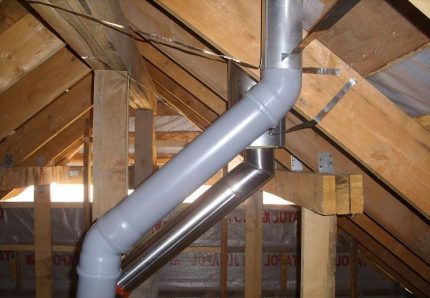
During the installation of natural hood, the following rules must be followed:
- The lattice in the bathroom / toilet should be in the upper part of the room - on the wall or in the ceiling.
- The inner surface of the pipes should be perfectly smooth.
- The protrusions and turns of the duct by 5% reduce the efficiency of circulation.
Natural ventilation is not considered very effective, since air flows cannot be controlled and influenced by their power. However, it is often used in multi-apartment residential buildings and is often used in suburban buildings used for seasonal living, for example, as a summer residence.
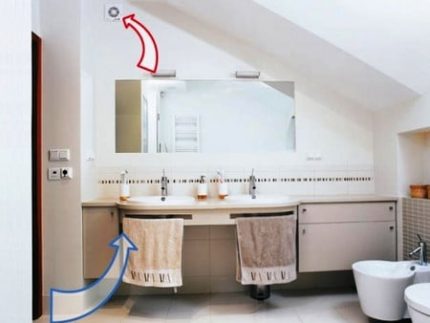
Features of forced ventilation
In the bathroom of buildings equipped with airtight window and door structures, mechanical evacuation of exhaust air using mechanical devices is used. It can be a consignment note or a channel fan.It turns on if necessary and creates traction.
In private buildings, canals are often mounted that discharge the exhaust air flow through the attic of the house. The fan is designed for efficient hoods polluted air, and fresh can enter the bathroom through an open door.
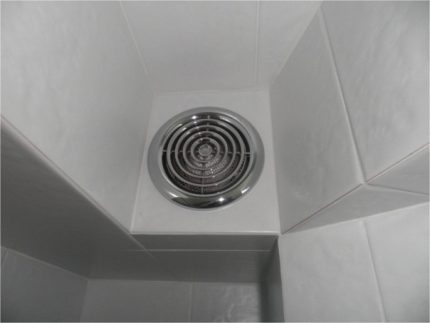
Types of fans for enclosed spaces
There are 2 types of equipment used in bathrooms, toilets and combined bathrooms. These are axial and radial exhaust devices. The latter are also called centrifugal.
Axial devices are a shaft on which a classic impeller is mounted. Her blades are made at an angle. When the shaft rotates, air is drawn in. Such a fan is used if the pressure created with it is sufficient to ensure normal air exchange.
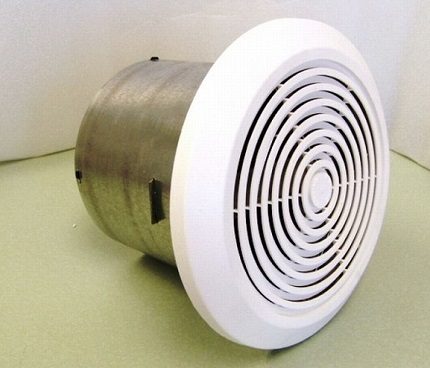
At radial devices, the air flow is drawn into the center, after which it appears in a casing with blades. Due to their location in the central part, rarefaction is observed, and the centrifugal force repels the air masses to the edges of the housing, which are discharged through the branch pipe into the ventilation duct.
Overhead models are most in demand - they work much more efficiently and quieter, they are able to evacuate volumes that are not axial. According to the degree of completeness, centrifugal fans of the principle of operation are divided into basic and with additional options. The second can work in automatic mode.
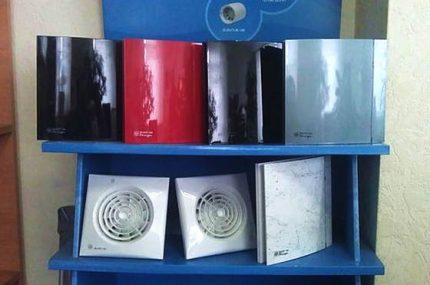
The main parameters of the hood for the bath
The specifics of the bathroom prompted developers to produce devices adapted to rooms with high humidity. The case of a fan powered by electricity must beairtight. The internal design of the equipment is reliably protected from all sides from exposure to wet steam.
Attention to the characteristics of the device
For consumers, the International Electrotechnical Commission has developed a certain standard for the reliability of electronic devices. It is denoted by IP and consists of two digits.
The value of the first can be from 0 to 6 and indicates the degree of protection against the penetration of impurities. The second digit defines moisture protection level. To use the product in the bathroom, the indicator should be at least 4.
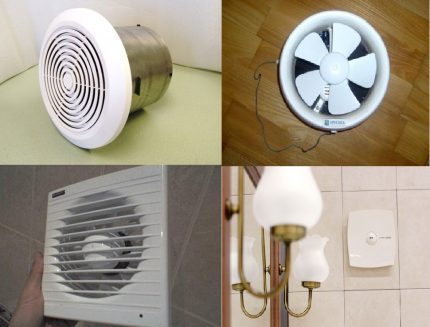
Power and performance are closely interconnected. The higher the first indicator, the greater the second. You can find out the performance indicator by multiplying the footage of the bathroom by the number of people living in the house.
If the fan is equipped with many additional functions, its power can exceed the calculated one by a maximum of 10%. The most popular are economical and almost silent devices that consume from 7 to 20 watts.
When devices with a high power indicator are working, a draft is observed in the room, and besides, it will not be able to warm up enough.
Another important characteristic is the noise level that the blades of the device create during operation. It is much quieter than when using a cooker hood. A sound acceptable for a fume hood is considered to be 30Db and below. This is due to the fact that a person perceives all sounds over 35Dbas unpleasant andintrusive.
Timer, hygrostat, check valve
Standard bathroom vents are mechanically controlled or operate in a slow, continuous mode. A timer is an optional device that allows you to automate the process by half.
After the man left the bathroom, exhaust fanThanks to the timer, it continues evacuating the exhaust air for some more time. At the end of which it disconnects itself.
The installation and connection manual for the exhaust device to the standard switch can be found in next article, which details these complex issues.

The presence of a humidity sensor is the best option for the bathroom. The hygrometer is considered the best control method, as it allows you to set the humidity threshold from 40 to 100%, upon reaching which the fan automatically turns on. Together, a hygrostat and a timer are used infrequently. Typically, with a humidity sensor, a timer is not required.
With equipment ventilation in a country house you need to measure the hole in the bathroom or in the bathroom, which will determine the diameter of the duct. The standard landing hood size is from 100 to 130 mm. If necessary, the hole in the bathroom wall can be enlarged using a hammer drill.
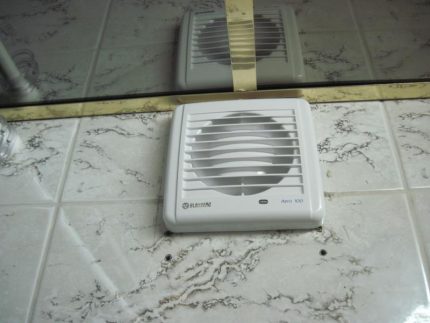
The non-return valve is a small and uncomplicated in design device that will not allow unpleasant odors from neighbors to enter the territory of your apartment. It is practically indispensable in city bathtubs and bathrooms connected to a common ventilation duct.
How to choose the right device?
When arranging the ventilation system in the bathroom, you will need to choose an exhaust device. First of all, you need to determine its capabilities, which are the ability to drive a specific amount of air. This indicator depends on the diameter of the device.
Manufacturers offer devices with a pipe section of 80, 100, 120, 150 mm. For Khrushchev, the diameter will be optimal 80 mm or 100 mm. In new buildings, the apartments have an improved layout, it is better to stay at a section of 120 mm.
An equally important factor is appearance. Many manufacturers produce hoods with a removable external panel. Fans Elicent, Electrolux, Ballu, Timberk and other brands come in various colors and shades.
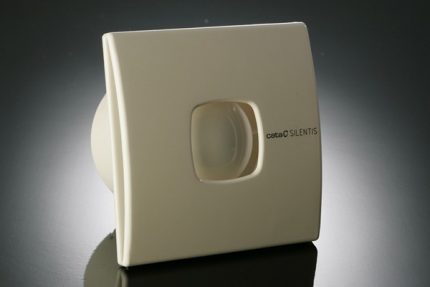
An attractive and stylish device can be made an accent element of the interior or fit it so that it is not striking. When choosing, one must take into account that water should not come into contact with electricity - the fan will have to work in conditions of high humidity.
To avoid problems with wiring, experts recommend using a product designed for long-term operation in such rooms.
It will be useful to check the noise figures of the device - unnecessary and unpleasant sounds play the role of a hearing irritant. When a high-quality fan in the bathroom is working, it happens almost silently.
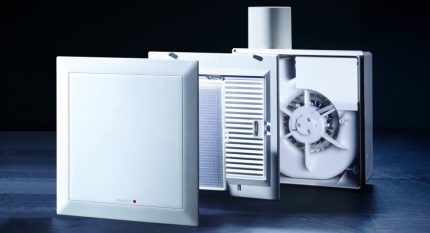
It is also worth paying attention to the strength and reliability of the device. A small part of companies specializing in the production of bathroom fans can guarantee that their products will work for several years. High quality is indicated by the warranty period from the manufacturer. If it is less than 1 year, it is better not to buy this device.
Preparing a place for an exhaust fan
Before installation, a number of preparatory work remains. First of all, it is necessary to check how well the ventilation duct functions by bringing a lit match or candle to the inlet. The flame should be tilted at an angle towards the grill.
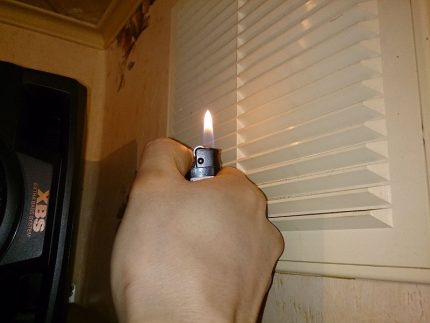
If the diameter of the ventilation duct opening is larger than the fan section, then you can insert a plastic or corrugated pipe the required diameter, and seal the voids with mounting foam, cutting off its excess with a sharp knife after setting the mortar.
In the case, the hole at the entrance to the shaft has a smaller diameter, it is expanded with a perforator.
Choosing the optimal connection scheme
Before installing any model of the exhaust fan in the bathroom, you need to decide how it will be connected to the power source.
Today there are different ways to connect the hood:
- The switch is located on the device. In this case, it can be turned on or off using the button or cord located on the case.
- Connecting the device to a separate switch. A switch is installed in front of the bathroom, in which one of the keys turns on the ventilation, and the second switches on the lighting.
- Automatic inclusion of the fan from the humidity or movement sensor. It begins to function if the permissible humidity level is exceeded or movement occurs.
- The device is connected to a light switch. It can be equipped with a timer and connected in parallel with the lamp. It turns on simultaneously with the lighting and turns off when the light is turned off.
The last way to connect the device is less in demand, as apartment residents often go into the bathroom for a short while to quickly wash their hands, brush their teeth, or wash themselves. In these cases, the included hood will be wasting energy.
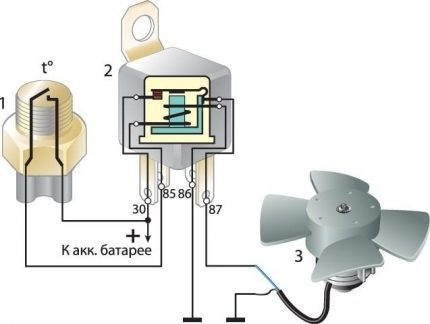
Laying wiring for better under the tile. If this is not possible, then you can mask the cable using special plastic boxes.
Installation procedure
Before connecting the fan in the bathroom, you should study the instructions that describe the detailed installation process. In accordance with the recommendations, the selected hood model is installed in the bathroom or in the bathroom.
Actions are performed in a certain sequence:
- First, remove the front cover and apply liquid nails, silicone or polymer glue to all areas where the product is adjacent to the wall surface. These materials will provide strong fastening of relatively lightweight plastic.
- We insert the device so that the working part together with the electric motor is completely in the wall. Press tightly to the mount for several minutes.
- We put a mosquito net, which will not allow various insects and midges to enter the room.
- We attach the front cover with the self-tapping screws that are included in the kit. this action is carried out last.
When connected to power, the room should not have open wires without insulation. They are placed in recessed ventilation ducts using a corrugated casing.
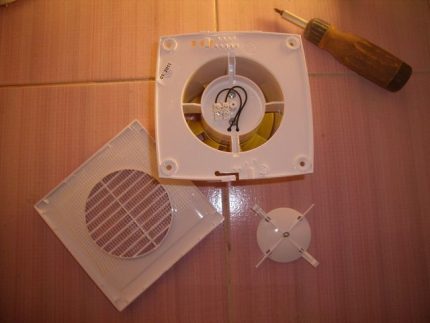
Many users connect fans through a contact pair to the light switch. The circuit breaker is set to phase.
For convenience, when using the appliance in the future, you can put a separate key to turn on the hood.If when visiting the bathroom there is no need for its work, it is convenient to use only the lighting control key. then the time spent in the room will not be overshadowed by the roar of rotating blades.
Conclusions and useful video on the topic
Video # 1. How to choose equipment and organize everything correctly:
Video # 2. Why do you need a hood for the bathroom and how to install it:
The hood allows you to get rid of high humidity in the bathroom and eliminate odors that penetrate the room. This is a popular and inexpensive equipment, characterized by ease of installation. Popular fan models are produced by manufacturers Ballu, Timberk, Elicent, Electrolux and others.
Despite the fact that installation work does not take much effort, money and time, the device will become an indispensable assistant in the fight for clean air and a comfortable microclimate.
Tell us how you improved ventilation in the bathroom by installing a hood. Share the intricacies of doing the work that are useful to site visitors. Ask questions, publish photos, comment on the material we presented in the block located under the text of the article.

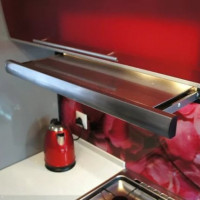 Hood without venting to ventilation: principle of operation, typical schemes and installation rules
Hood without venting to ventilation: principle of operation, typical schemes and installation rules 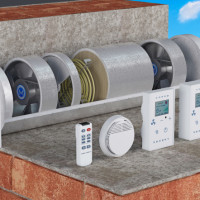 Heated ventilation in the apartment: types of heaters, especially their selection and installation
Heated ventilation in the apartment: types of heaters, especially their selection and installation  Exhaust fan in the bathroom: how to choose the right + installation rules
Exhaust fan in the bathroom: how to choose the right + installation rules 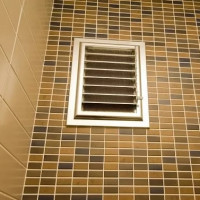 Ventilation in the bathroom and toilet: principle of operation, typical schemes and installation features
Ventilation in the bathroom and toilet: principle of operation, typical schemes and installation features  How to make ventilation in the country: subtleties and rules for installing ventilation of a country house
How to make ventilation in the country: subtleties and rules for installing ventilation of a country house  Duct-mounted ducted air conditioner: subtleties of choice and installation
Duct-mounted ducted air conditioner: subtleties of choice and installation  How much does it cost to connect gas to a private house: the price of organizing gas supply
How much does it cost to connect gas to a private house: the price of organizing gas supply  The best washing machines with dryer: model rating and customer tips
The best washing machines with dryer: model rating and customer tips  What is the color temperature of light and the nuances of choosing the temperature of the lamps to suit your needs
What is the color temperature of light and the nuances of choosing the temperature of the lamps to suit your needs  Replacement of a geyser in an apartment: replacement paperwork + basic norms and requirements
Replacement of a geyser in an apartment: replacement paperwork + basic norms and requirements
The bathroom in a private house has yet to be completed. I am gathering information. In this regard, I found very useful material. Definitely, a forced wall-mounted hood will be arranged. As for the inclusion method, I still doubt it. In combination with the light, or is it still a timer? Necessarily a device with a diffuser and, most likely, overhead type. With gratitude I will accept recommendations from knowledgeable people.
The best option is a fan with a humidity switch (hygrostat). It turns on only when the humidity reaches the set threshold and it really becomes necessary.
A hood in the bathroom is a very cool and useful thing! Previously, after visiting the bathroom had to drain it by opening the door to the bathroom wide open. It was still not enough just to open and leave the gap. It was not very pleasant and aesthetically pleasing, especially if suddenly someone rang the doorbell (the door to the bathroom opposite the front door), rushed to close the bathroom first. Now I turn on the hood and just go out of the bathroom. Drains in half an hour. We have a model with a timer. Convenient - not to convey in words.